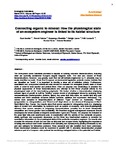Connecting organic to mineral: How the physiological state of an ecosystem-engineer is linked to its habitat structure
| dc.contributor.author | Curd, A | |
| dc.contributor.author | Pernet, F | |
| dc.contributor.author | Corporeau, C | |
| dc.contributor.author | Delisle, L | |
| dc.contributor.author | Firth, Louise | |
| dc.contributor.author | Nunes, FLD | |
| dc.contributor.author | Dubois, SF | |
| dc.date.accessioned | 2019-01-15T15:59:48Z | |
| dc.date.available | 2019-01-15T15:59:48Z | |
| dc.date.issued | 2019-03 | |
| dc.identifier.issn | 1470-160X | |
| dc.identifier.issn | 1872-7034 | |
| dc.identifier.uri | http://hdl.handle.net/10026.1/13142 | |
| dc.description.abstract |
© 2018 Elsevier Ltd The honeycomb worm Sabellaria alveolata is capable of building extensive bioconstructions, including what are currently considered Europe's largest biogenic reefs. The size and volume of these bioconstructions, however, vary greatly, such that not all habitats engineered by S. alveolata may be easily identified as reefs. Given that European environmental legislation protects marine habitats that are classified as “reefs” it is important to identity a clear set of definition criteria. Furthermore, quantifiable and unequivocal criteria are also needed to evaluate the ecological (health) state of these reefs, in order to best monitor and protect them. Here we propose new terminology to describe the physical appearance of these bioconstructions and attempt to link these physical criteria to the physiological state of the tube-building polychaete. We tested whether a bioconstruction displaying outward signs of growth is built by “healthy” worms devoid of physiological stress by analysing three macromolecules (carbohydrates, proteins, lipids), four polar lipid fatty acids, six neutral lipid fatty acid markers and three metabolic enzymes (citrate synthase, catalase and superoxide dismutase). The worms were sampled in bioconstructions of different “Type” (veneer vs. hummock), “Phase” (progradation vs. retrogradation), and “Shore Level” (high shore vs. low shore) at Champeaux in Mont-Saint-Michel Bay, France. Our results show that worms sampled in retrograding reefs (i.e. displaying signs of erosion and colonisation by epibionts such as oysters or mussels), were less physiologically stressed than worms sampled in prograding bioconstructions, possibly due to lower intraspecific competition and hence greater food availability. We therefore suggest management measures should encompass the whole mosaic of biogenic construction Types and Phases. We propose the inclusion of the polar lipid fatty acid arachidonic acid, in combination with the activity of two metabolic enzymes, citrate synthase and superoxide dismutase, as the three key biochemical markers to consider for quantitative information on the physiological state of this particular ecosystem engineer. Our results also revealed the influence of both sex and size on fatty acid and enzyme levels, highlighting the importance of taking into account both these variables when sampling and subsequently pooling individuals by sex and size category for laboratory analyses. Once seasonal and site variation have been addressed, these biochemical indicators could be examined in parallel with S. alveolata bioconstruction physical criteria as part of a European-wide protocol for monitoring ecological status in this potential reef habitat. | |
| dc.format.extent | 49-60 | |
| dc.language | en | |
| dc.language.iso | en | |
| dc.publisher | Elsevier | |
| dc.subject | Biochemical indicators | |
| dc.subject | Health | |
| dc.subject | Ecological status | |
| dc.subject | Sabellaria alveolata | |
| dc.subject | Biogcnic reef | |
| dc.subject | Engineer species | |
| dc.title | Connecting organic to mineral: How the physiological state of an ecosystem-engineer is linked to its habitat structure | |
| dc.type | journal-article | |
| dc.type | Journal Article | |
| plymouth.author-url | https://www.webofscience.com/api/gateway?GWVersion=2&SrcApp=PARTNER_APP&SrcAuth=LinksAMR&KeyUT=WOS:000464891100006&DestLinkType=FullRecord&DestApp=ALL_WOS&UsrCustomerID=11bb513d99f797142bcfeffcc58ea008 | |
| plymouth.volume | 98 | |
| plymouth.publication-status | Published | |
| plymouth.journal | Ecological Indicators | |
| dc.identifier.doi | 10.1016/j.ecolind.2018.10.044 | |
| plymouth.organisational-group | /Plymouth | |
| plymouth.organisational-group | /Plymouth/Faculty of Science and Engineering | |
| plymouth.organisational-group | /Plymouth/Faculty of Science and Engineering/School of Biological and Marine Sciences | |
| plymouth.organisational-group | /Plymouth/REF 2021 Researchers by UoA | |
| plymouth.organisational-group | /Plymouth/REF 2021 Researchers by UoA/UoA07 Earth Systems and Environmental Sciences | |
| plymouth.organisational-group | /Plymouth/Users by role | |
| plymouth.organisational-group | /Plymouth/Users by role/Academics | |
| dcterms.dateAccepted | 2018-10-21 | |
| dc.rights.embargodate | 2019-10-30 | |
| dc.identifier.eissn | 1872-7034 | |
| dc.rights.embargoperiod | Not known | |
| rioxxterms.versionofrecord | 10.1016/j.ecolind.2018.10.044 | |
| rioxxterms.licenseref.uri | http://www.rioxx.net/licenses/all-rights-reserved | |
| rioxxterms.licenseref.startdate | 2019-03 | |
| rioxxterms.type | Journal Article/Review |


